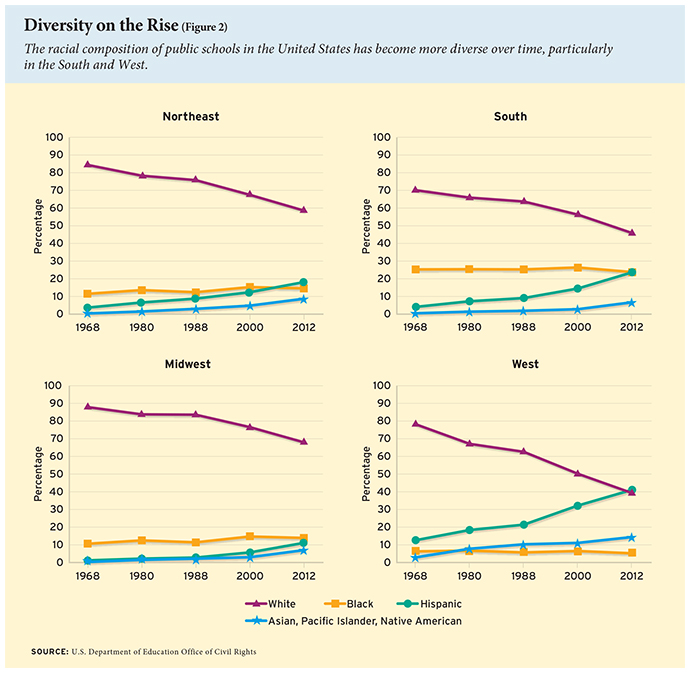This article is part of a new Education Next series commemorating the 50th anniversary of James S. Coleman’s groundbreaking report, “Equality of Educational Opportunity.” The full series will appear in the Spring 2016 issue of Education Next.
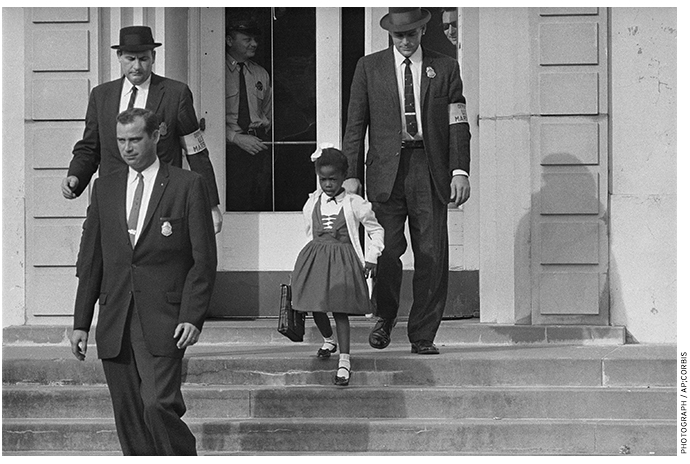
The aim of racial integration of our schools should be recognized as distinct from the aim of providing equal opportunity for educational performance.
To confound these two aims impedes the achievement of either.
–James S. Coleman,
“Toward Open Schools,” The Public Interest (1967)
Equality of Educational Opportunity, also known as the Coleman Report, sought answers to two burning questions: 1) How extensive is racial segregation within U.S. schools? 2) How adversely does that segregation affect educational opportunities for black students? In answering the first question, James S. Coleman and his co-authors documented the de facto segregation found in all parts of the United States, including the South, where the Supreme Court had declared de jure segregation unconstitutional in Brown v. Board of Education (1954). Regarding the second question, Coleman reported that families were more important for learning than were school resources, and, further, that school resources varied more by region than they did by a school’s racial composition within any specific region. Yet Coleman also noted that the composition of a student’s peer group was more important for learning than any other school-related factor, a finding used by the Johnson and Nixon administrations to reinforce their strenuous desegregation efforts in southern states.
Today, questions about the effects of changes in housing patterns and recent Supreme Court decisions that weaken desegregation efforts remain central to discussions of educational opportunity and racial achievement gaps. On the first issue, more specifically, have changes over time in housing and school attendance patterns reduced the isolation of black children in the public schools? The answer depends on the specific way progress is measured. If we ask whether the average black student is exposed to more white students in public school today than a half century ago, the answer is yes, although fewer than in the 1980s; after rising in the 1970s, the rate of exposure has declined markedly since 1988. Another measure of progress toward integration is the dissimilarity index, which measures how much the racial composition of the schools would have to change for each school to have the same percentage of whites and blacks as these groups constitute in the school-age population as a whole. By this measure, schools are closer to complete integration than ever before, and thus racial composition would have to change less now than when the report was released. How can two questions that seem so similar have such different answers? The explanation is in the changing demographic composition of the schools: the percentage of students who are white has declined dramatically over the past 50 years, while the percentage of students who are black has changed very little.
Detailing these changes is my first task. My second task is to inquire into the consequences for achievement of the racial segregation that still persists. Unfortunately, it is difficult to speak definitively about this matter. The required social scientific research has yet to be pursued adequately, despite the pathbreaking contribution of the Coleman Report and serious scholarly inquiry since. One can say—without much scholarly help at all—that racial segregation is undoubtedly harmful to the well-being of a multi-ethnic society that aspires to equal opportunity for all. But if one digs deeper to measure the adverse effects of segregation on the learning of African American students, a topic to which Coleman gave full attention, then one can only reach cautious judgments. The best answer, in my view, is that the consequences of racial segregation for student learning are probably adverse but not severely so.
School Enrollment Patterns since 1968
In 1954, the Supreme Court in Brown v. Board of Education found legally segregated schools to be unconstitutional, but it was not until the legislative and executive branches put the full strength of the federal government behind desegregation efforts, by passing the Civil Rights Act of 1964 and the Voting Rights Act of 1965, that serious progress was made in the South. Even then, many hiccups occurred as public opinion wavered between the idealism of the civil rights years and the backlash instigated by civil unrest in major cities during the late 1960s and early 1970s. Courts, too, varied in their commitment to desegregation. In Milliken v. Bradley (1974), the Supreme Court found that de facto segregation, which occurred as the result of residential decisions made by individuals, did not violate the equal protection clause of the U.S. Constitution’s 14th Amendment. These were private decisions, not decisions made by government, and therefore not subject to constitutional constraint. Many white families left city schools for nearly all-white suburban districts when integration plans were put forward.
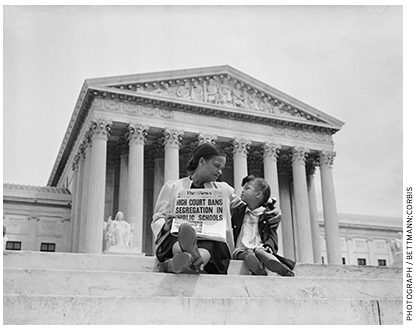
In the 1990s, the Court softened its previous position on desegregation in schools that once had had de jure segregation. It said that districts had merely to take all practical steps to end the legacy of segregation (Board of Education of Oklahoma City Public Schools v. Dowell, 1991). The Court also decided that school districts could not be held constitutionally responsible for low student achievement in segregated settings (Missouri v. Jenkins, 1995).
Given the ups and downs in the legal and political environments, it is entirely possible that both the rate and direction of school desegregation have fluctuated significantly over the 50 years since the Coleman Report. To ascertain whether this is the case, I draw on the best available public data on the racial composition of the nation’s schools: the Public Elementary and Secondary School Enrollment and Common Core of Data issued by the Office for Civil Rights within the U.S. Department of Education. To capture the shifts that took place during four distinctly different time periods, I identify the state of racial segregation in schools for the years 1968, 1980, 1988, 2000, and 2012. (Reliable information for the small number of students attending schools in districts with enrollment below 300 is unavailable for the years prior to 2000.)
Three interrelated pieces of information characterize school enrollment patterns, and I document changes over time in all three: the degree of interaction, as measured by black student exposure to white students; dissimilarity indexes for schools and districts; and overall demographic composition. For each of the five years, Figure 1 presents three data points:
1) The exposure index measures the likelihood that a black student will interact with white students, as measured by the average percentage of black children’s schoolmates who are white.
2) The dissimilarity index measures the extent to which schools and the overall student population are racially dissimilar, by calculating the percentage of blacks that would need to change schools if all schools were to have the same percentage of black students. The index is equal to 0 if there is complete integration and 100 if there is complete segregation. As the potential for desegregation efforts is determined by the distribution of students among districts, I report the index for districts as well as for schools.
3) A simple demographic indicator identifies the percentages of students who are black, white, or from another racial group.
Residential choices, school choices made by families, and district school attendance rules jointly determine student enrollment patterns. The enrollment data do not provide information on residential location or private school enrollment. A dissimilarity index at the district level, however, measures the dissimilarity of districts and the overall student population in the area, and provides information on changes over time in racial differences in the distribution of students among districts.
The Trend Data
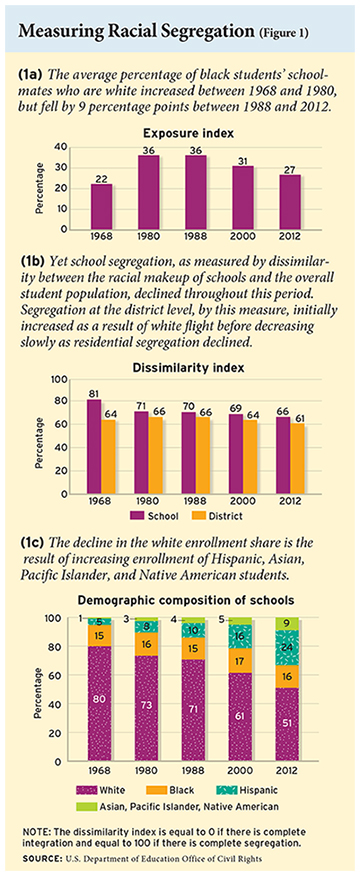 I begin with a discussion of the exposure index, as contact between black students and white students was a major focal point of the Coleman Report. As Figure 1a shows, the exposure index rose rapidly between 1968 and 1980, from 22 percent to 36 percent, a change in the extent of racial interaction that has not been matched since. Over that period, the federal government was aggressively promoting school desegregation in the South, and civil rights groups were attempting to extend their efforts to other parts of the United States. Few remember that the Nixon administration conditioned federal aid to southern schools on their compliance with desegregation court orders; that policy appears to have aided the desegregation efforts that federal courts were insisting upon. The trend line stabilizes during the 1980s and heads downward after 1988, slipping to 31 percent by 2000 and 27 percent in 2012, landing above the level that existed at about the time the Coleman Report was released.
I begin with a discussion of the exposure index, as contact between black students and white students was a major focal point of the Coleman Report. As Figure 1a shows, the exposure index rose rapidly between 1968 and 1980, from 22 percent to 36 percent, a change in the extent of racial interaction that has not been matched since. Over that period, the federal government was aggressively promoting school desegregation in the South, and civil rights groups were attempting to extend their efforts to other parts of the United States. Few remember that the Nixon administration conditioned federal aid to southern schools on their compliance with desegregation court orders; that policy appears to have aided the desegregation efforts that federal courts were insisting upon. The trend line stabilizes during the 1980s and heads downward after 1988, slipping to 31 percent by 2000 and 27 percent in 2012, landing above the level that existed at about the time the Coleman Report was released.
Figure 1b shows the dissimilarity index—the percentage of blacks who would need to change schools if blacks and whites were to attend each school in the same percentage as their percentage of public school enrollment. This school dissimilarity index fell from 81 percent to 71 percent between 1968 and 1980, when southern schools were taking strong steps to eliminate de jure segregation. And it continued to decline—albeit at a slower pace—after 1980, falling to 66 percent by 2012.
How is it that segregation continued to decline as the exposure rate fell? The explanation can be found in the dramatic change in the composition of the public school population (see Figure 1c). Between 1968 and 2012, the percentage white of overall student enrollment in public schools dropped from 80 percent to 51 percent. Between 1988 and 2012, when the exposure index slid 9 percentage points (from 36 percent to 27 percent), the white percentage of all public-school enrollment tumbled by 20 percentage points (from 71 percent to 51 percent). As the white population was becoming older, other groups were capturing an ever-larger share of the student population. African Americans were not replacing whites—their share of the school-age population edged upward by less than 1 percentage point over the entire 44-year time period. Rather, an influx of Hispanic and Asian families transformed the composition of the schools. The result is a declining black‒white exposure rate: it became increasingly difficult to increase interactions between blacks and whites because there were ever-fewer whites in the schools.
The steps taken to desegregate schools and increase black student exposure to white students were not strong enough after 1980 to offset the demographic shifts that were increasing the amount of contact between both whites and blacks and the children of immigrants from Latin America, Asia, and elsewhere. Nonetheless, the decline in the exposure index prompted former Business Week correspondent William C. Symonds, in “Brown v. Board of Education: A bittersweet birthday” (May 2004), and others to decry the resegregation of America’s schools. That claim overlooks the powerful effect demographic change has had on the possibility of increasing black student exposure to white students.
Figure 2 shows trends in the demographic composition of schools in the four geographic regions of the U.S. The percentage of white students has fallen steadily in the Northeast and Midwest, with modest upticks in the proportion of students who are black, Hispanic, or from other groups. The West has seen the most dramatic decline in white students and the largest increase in Hispanic students. Schools in the South have arguably seen the greatest increase in diversity as the four trend lines come closest to converging.
White Flight and District Policies
A pronounced increase in Hispanic and Asian public-school enrollment and consequent decline in the white enrollment share, not a pattern of resegregation, has driven the fall in the exposure of black students to white schoolmates. This does not mean, however, that family decisions, court policies, and school board responses are irrelevant to the patterns of racial segregation that continue to persist. For example, white flight from integrating schools, a topic that Coleman (in other studies) explored in considerable depth, certainly slowed the rate of desegregation, especially during the years 1968 to 1980, when the most aggressive desegregation steps were being taken.

The 1974 Supreme Court decision in Millikin v. Bradley found no constitutional violation when de facto segregation resulted from the private choices of individuals to live in one part of a metropolitan area rather than another. As a result, white suburban school districts were under no constitutional requirement to integrate their schools when their new white students had fled a central-city school district that was promulgating a desegregation plan. Between 1968 and 1980, the district dissimilarity index (which measures the amount of black students who would have to move to another district in order to achieve the same percentage of whites and blacks in all districts) increased from 64 to 66 percent. Thus, by this measure, district segregation was increasing at the same time that the overall rate of school segregation was falling by 10 percentage points. This does not capture any movement of white students to private schools.
A closer examination of the district dissimilarity index offers some suggestive evidence as to the forces at work. Between 1968 and 1980, segregation by district increased, reflecting the effects of both white flight from desegregation and longer-term trends, including suburbanization. In contrast, following 1988, segregation by district fell by almost 10 percent, from 66 to 61. Black‒white segregation among districts in 2012 is roughly 5 percent lower than it was in 1968, prior to the onset of the most far-reaching desegregation efforts.
Housing patterns are the primary determinant of segregation among districts, but the district dissimilarity index provides only a crude measure of the extent of housing segregation. First, private school‒enrollment levels influence the measure of district segregation. Second, trends in segregation by district do not capture changes in residential segregation within districts. Therefore, it is important to examine residential segregation directly, and evidence clearly shows a decline in housing segregation during this period. Using 1980, 1990, and 2000 U.S. Census information, John Iceland and D. H. Weinberg in 2002 constructed dissimilarity indexes of residential segregation by census tract in 220 metropolitan areas in which at least 3 percent of the residents were black or which had at least 20,000 black residents in 1980. The median index declined from 0.75 in 1980 to 0.65 in 2000, a decrease of more than 13 percent. William Frey finds in a 2015 study that the decline in residential segregation continued to 2010, at least in the 102 metropolitan areas with populations greater than 500,000. Over that more recent decade, there was a decrease in residential segregation of 3.1 percent within these large metropolitan areas.
As Coleman observed, white flight from desegregation intensified segregation between districts. Finis Welch and Audrey Light published a study in 1987 that used 16 years of data on enrollments and desegregation program status to study in detail the changes in white enrollment surrounding the implementation of 116 major desegregation plans between 1967 and 1985. Among other findings, they concluded that 1) white enrollment declined much more in the year of plan implementation than in subsequent years, and 2) pairing and clustering, the desegregation technique that involved the joining of schools with initially very different black and white enrollment shares into a single attendance zone, produced the largest average white-enrollment losses surrounding plan implementation in the period of greatest desegregation activity. Because pairing and clustering mandates student involvement in desegregation and typically requires that students travel greater distances than under the redrawing of school catchment areas or other voluntary desegregation plans, the finding that this plan type produces the largest enrollment response is consistent with expectations.
It is not clear a priori whether white flight would be greater in urban districts surrounded by suburbs or in large countywide districts found in the South. The larger geographical spread of countywide districts raises the cost to families of moving out of the district but also raises transportation issues for school districts that want to desegregate throughout the entire county. Welch and Light found that white flight is generally less in countywide districts than in central-city districts (surrounded by a suburban belt) despite the fact that the countywide districts take stronger steps to reduce segregation within the schools. Apparently, the costs to families of moving out of the countywide district for predominantly white outlying areas are so large they more than offset any perceived advantage of escaping the changes in the demographic composition of the schools. Also, a separate study by Sarah Reber has shown that the more districts within a metropolitan area, the greater the white flight, another indication that families balance their school preferences against the cost of moving long distances. White flight almost certainly altered the effects of desegregation policies in many cities, especially in places such as the Northeast, where school districts within metropolitan areas tend to be small and numerous.
After 1980, district segregation stabilized and eventually began to subside (see Figure 1b). It is possible that whites became more tolerant of a black presence at school, or that districts began relying more extensively on voluntary tools to desegregate schools, avoiding the politically unpopular measures that provoked so much opposition in the years immediately following the release of the Coleman Report.
A growing number of school districts have been released recently from court supervision as the result of court decisions handed down during the 1990s, raising the possibility of resegregation of public school districts where desegregation had taken place. A small but growing body of research has investigated the effects of release. Studies by Sean Reardon and his colleagues in 2012 and Byron Lutz in 2011, using variation in the timing of court supervision to identify the effects on segregation, discern an increase in segregation following the cessation of court supervision, although the magnitude appears to be modest.
Academic and Social Outcomes
The Coleman Report revealed substantial achievement differences by school racial composition and emphasized the importance of considering various factors that contributed to those differences:
· different facilities and curricula in the school itself
· variations in educational deficiency or proficiency of fellow students that are correlated with race
· effects due to racial composition of the student body apart from its level of educational proficiency.
Unfortunately, Coleman’s methodological approach was not capable of identifying the independent effect of each of these factors.
Subsequent research has grappled with these issues in one form or another in an effort to gain a better understanding of the determinants of racial differences in academic, economic, and social outcomes. But isolating the causal effect of school desegregation has proven difficult. Consider the substantial improvement of black students relative to white students on the National Assessment of Educational Progress (NAEP) during the 1970s and 1980s. The timing coincides with the desegregation of many school districts, especially in the South, but other policy, economic, and social changes may also have influenced the achievement gap. Most notably, economic and social opportunities were broadening for African Americans, the civil rights movement may have given the black community higher expectations for its youth, and white respect for black peers may have increased in the larger society, regardless of the racial composition of the school.
Despite the challenges of isolating the impact of school desegregation on student achievement, a small but growing body of research provides valuable evidence on the relationship between segregation policies and students’ academic and social outcomes. A 2009 study I conducted with Eric A. Hanushek and colleagues uses administrative data from the State of Texas Department of Education for multiple student cohorts to identify the effect of racial composition of the classroom on learning. By controlling for a wide variety of other characteristics, including the students’ own prior performance, our analysis is able to estimate the likely effect of desegregation within the school. We find that black achievement levels are negatively associated with the percentage black in a grade, indicating that desegregation policies that reduced this percentage were having the desired effect. Interestingly, those who had higher initial achievement levels benefited the most from a desegregated environment. These findings are based on variations in racial composition of grades within a given school. While informative, they do not conclusively show the effects of policies that alter the overall racial composition of a school through changes in attendance patterns, the policies that are of greatest concern to both the courts and to state and district policymakers.
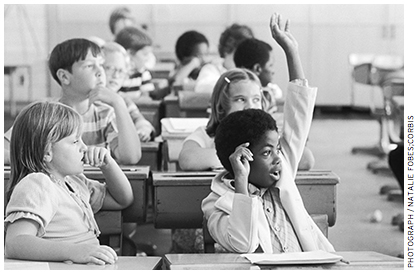
A handful of experimental studies of desegregation programs compare participants with nonparticipants. Thomas Cook, writing in 1984, concludes that meta-analyses of results from all the studies, taken together, support the view that the effects on the mathematics and reading achievement in elementary school are quite small or even zero. The small sample sizes common to the studies he summarizes, however, make it difficult to identify potentially important effects. In addition, these studies capture only the most direct impacts of the desegregation program and are limited to a few interventions that may not be typical.
Several studies have examined the average effect of either the introduction or the removal of desegregation programs using variation in timing across districts. Jonathan Guryan in 2002 used the desegregation plan data assembled by Welch and Light to study the change in high-school dropout rates between 1970 and 1980, and found that the implementation of desegregation during the 1970s reduced the high-school dropout rate during that period. In addition, Lutz’s 2011 study found that resegregation increased the probability of dropping out for blacks living outside of the South. Even though these studies are among the most compelling in this area of research, the complications introduced by the purposeful choices and responses of families and schools temper the strength of the findings.
In a 2014 study, Stephen Billings and his colleagues used administrative data and variation in school assignments for students who lived on opposite sides of new catchment area boundaries in Charlotte-Mecklenburg, North Carolina, following the district’s release from court supervision to identify the effects of changes in racial composition and school resources. The paper reveals substantial evidence of resegregation and a significant increase in the probability of being arrested for black students, but no increase in the probability of dropping out of high school as a result of the change in the racial composition of the school. Importantly, it appears that changes in resources rather than peer composition drive the results.
Taken as a whole, the evidence on racial composition, desegregation, and resegregation effects suggests that desegregation had a positive but likely uneven effect on academic and social outcomes. It is very likely the case that program effects differ by both programmatic details and context, and consequently variation in findings does not constitute evidence that some studies must be flawed. The absence of an evaluation component from most desegregation programs has both complicated efforts to measure short- and long-term program effects and hindered the development of more effective strategies to improve outcomes and reduce achievement gaps.
Coleman’s Legacy
Half a century has passed since the publication of the Coleman Report, and the persistent racial gaps in achievement, academic attainment, earnings, crime, poverty, and extensive school segregation that remain provide prima facie evidence that equality of opportunity remains elusive. Nevertheless, the report served as a catalyst for a fundamental change in education research and the framework within which policymakers, educators, and citizens conduct debates over education policy. Such discussions are no longer conducted in a vacuum. On the contrary, requirements for the reporting of extensive information on academic outcomes and basic characteristics of schools, including their demographic composition, have been embedded in federal and state laws. The creation of the Institute of Education Sciences illustrates another legacy of the Coleman Report: a commitment to rigorous quantitative research.
The greater breadth of today’s research agenda is likely to move our understanding of the contemporary impact of racial isolation and the policies introduced to ameliorate it. Research on teacher quality, charter schools, school leadership, class size, and other factors in school quality is likely to be as or more important than research on race-specific policies for reducing gaps in student achievement. The legacy of the Coleman Report enhanced the research community’s commitment to improve the measurement of school and teacher performance. It also broadened public understanding of the types of interventions that will elevate the academic, social, and economic outcomes of disadvantaged students in a manner that will give meaning to the notion of equality of opportunity.
Steven Rivkin is professor of economics at the University of Illinois at Chicago.
This article appeared in the Spring 2016 issue of Education Next. Suggested citation format:
Rivkin, S. (2016). Desegregation Since the Coleman Report: Racial composition of schools and student learning. Education Next, 16(2), 28-37.


